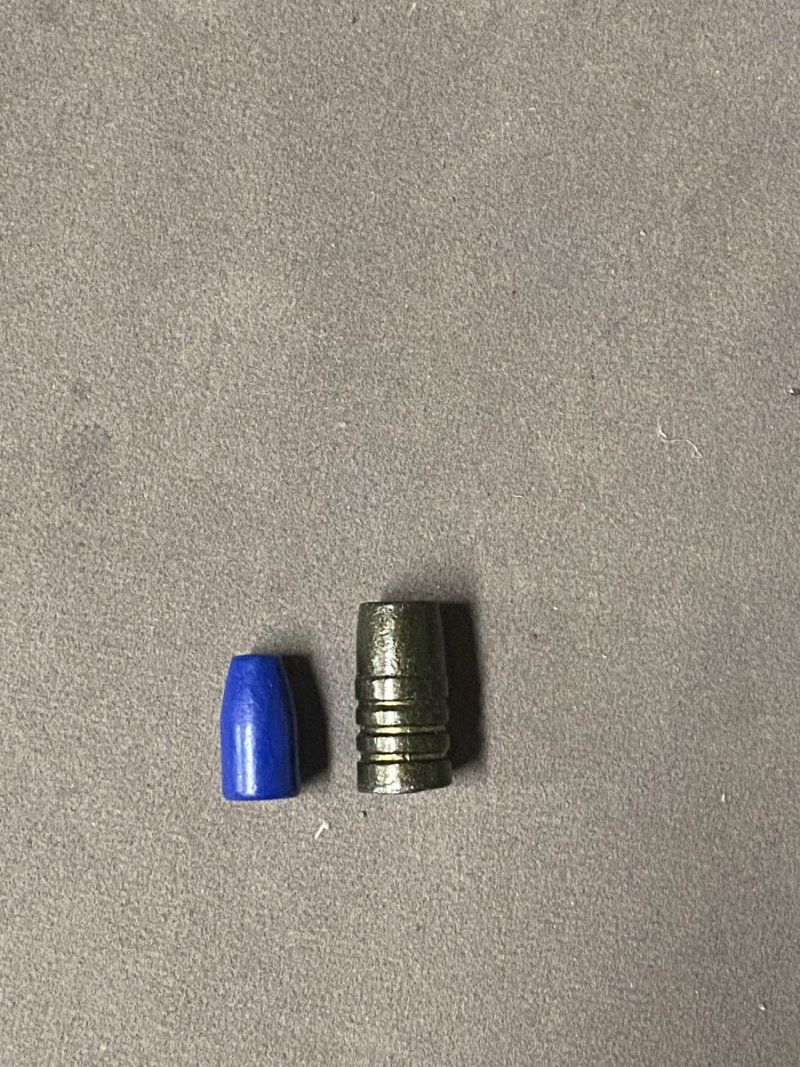I was thinking about 308's and decided I'd like to find out what the differences are between the loads mentioned, so I did a little figuring.
Here's a comparison between the 150,180, and 220-grain .308 loadings in my reloading manual. For kicks, I threw in a 30-30 number at the end.
The recoil numbers from an 8.25lb rifle are as follows:
150-grain bullet @ 2700 fps = 13.13lbs
180-grain bullet @ 2450 fps = 14.32lbs
220-grain bullet @ 2200 fps = 14.95lbs
170-grain bullet @ 2100 fps = 10.67lbs (30-30 7lb rifle)
Sectional density with Hornady InterLock round nose bullets are as follows:
150-grain = .226
180-grain = .271
220-grain = .331
170-grain = .256 (Hornady InterLock flat point 30-30)
Energy, Momentum, and Taylor K.O. numbers are as follows:
150-grain = 2427ft lbs , 57(m) , 17(k.o.)
180-grain = 2398ft lbs , 63(m) , 19(k.o.)
220-grain = 2153ft lbs , 66(m) , 20(k.o.)
170-grain = 1664ft lbs , 51(m) , 15(k.o.)
Ballistic Coefficients are as follows:
150-grain = .186
180-grain = .241
220-grain = .300
170-grain = .189
A condensed version of Ballistics:
308 sighted in at 100-yard zero, with 1.5" high scope
30-30 sighted in at 75-yard zero, with 0.75" high iron sights
150-grain @ 2700 fps
60 yards ~ velocity (2415 fps) , impact (0.1") , energy (1943ft lbs)
150 yards ~ velocity (2037 fps) , impact (-1.71") , energy (1382ft lbs)
180-grain @ 2450 fps
60 yards ~ velocity (2479 fps) , impact (0.07") , energy (2456ft lbs)
150 yards ~ velocity (2180 fps) , impact (-1.53") , energy (1900ft lbs)
220-grain @ 2200 fps
60 yards ~ velocity (2043 fps) , impact (0.39") , energy (2039ft lbs)
150 yards ~ velocity (1828 fps) , impact (-2.57") , energy (1632ft lbs)
170-grain @ 2100 fps
60 yards ~ velocity (1861 fps) , impact (0.28") , energy (1307ft lbs)
100 yards ~ velocity (1716 fps) , impact (-1") , energy (1112ft lbs)
120 yards ~ velocity (1647 fps) , impact (-2.33") , energy (1024ft lbs)
The idea is to use it as a nice woods gun, and explore the potential of the cartridge.
I'd be interested to hear what 308 loads have worked best and if anyone has experience with the heavier loads. I know I left out the 165-grain bullet (and several others), but it wasn't offered in a round nose and I skipped over it. I may edit the post and add it to the comparison in the future, but for now, these are all round nose Hornady bullets (save 30-30). Feel free to list whatever .308 bullet you've used in the field and how you've liked it, be it mentioned or not.
My guess is that the quickest kills come from the 150's and 165's and that the 180's and 220's may tend to pass through without doing as much damage to surrounding tissue (unless contacting a bone).
Here's a comparison between the 150,180, and 220-grain .308 loadings in my reloading manual. For kicks, I threw in a 30-30 number at the end.
The recoil numbers from an 8.25lb rifle are as follows:
150-grain bullet @ 2700 fps = 13.13lbs
180-grain bullet @ 2450 fps = 14.32lbs
220-grain bullet @ 2200 fps = 14.95lbs
170-grain bullet @ 2100 fps = 10.67lbs (30-30 7lb rifle)
Sectional density with Hornady InterLock round nose bullets are as follows:
150-grain = .226
180-grain = .271
220-grain = .331
170-grain = .256 (Hornady InterLock flat point 30-30)
Energy, Momentum, and Taylor K.O. numbers are as follows:
150-grain = 2427ft lbs , 57(m) , 17(k.o.)
180-grain = 2398ft lbs , 63(m) , 19(k.o.)
220-grain = 2153ft lbs , 66(m) , 20(k.o.)
170-grain = 1664ft lbs , 51(m) , 15(k.o.)
Ballistic Coefficients are as follows:
150-grain = .186
180-grain = .241
220-grain = .300
170-grain = .189
A condensed version of Ballistics:
308 sighted in at 100-yard zero, with 1.5" high scope
30-30 sighted in at 75-yard zero, with 0.75" high iron sights
150-grain @ 2700 fps
60 yards ~ velocity (2415 fps) , impact (0.1") , energy (1943ft lbs)
150 yards ~ velocity (2037 fps) , impact (-1.71") , energy (1382ft lbs)
180-grain @ 2450 fps
60 yards ~ velocity (2479 fps) , impact (0.07") , energy (2456ft lbs)
150 yards ~ velocity (2180 fps) , impact (-1.53") , energy (1900ft lbs)
220-grain @ 2200 fps
60 yards ~ velocity (2043 fps) , impact (0.39") , energy (2039ft lbs)
150 yards ~ velocity (1828 fps) , impact (-2.57") , energy (1632ft lbs)
170-grain @ 2100 fps
60 yards ~ velocity (1861 fps) , impact (0.28") , energy (1307ft lbs)
100 yards ~ velocity (1716 fps) , impact (-1") , energy (1112ft lbs)
120 yards ~ velocity (1647 fps) , impact (-2.33") , energy (1024ft lbs)
The idea is to use it as a nice woods gun, and explore the potential of the cartridge.
I'd be interested to hear what 308 loads have worked best and if anyone has experience with the heavier loads. I know I left out the 165-grain bullet (and several others), but it wasn't offered in a round nose and I skipped over it. I may edit the post and add it to the comparison in the future, but for now, these are all round nose Hornady bullets (save 30-30). Feel free to list whatever .308 bullet you've used in the field and how you've liked it, be it mentioned or not.
My guess is that the quickest kills come from the 150's and 165's and that the 180's and 220's may tend to pass through without doing as much damage to surrounding tissue (unless contacting a bone).





